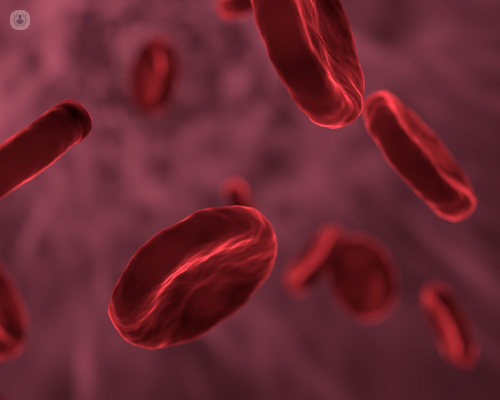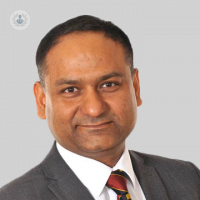Orthobiologics: Utilising the healing power of the human body
Escrito por:People with chronic pain may find that traditional treatments don’t provide sufficient relief and look towards orthobiologics as a natural, complementary option.
Mr Rohit Jain, highly experienced consultant orthopaedic surgeon, speaks to Top Doctors about this field of treatment, covering topics including the various substances or products used, if it’s right for patient’s specific requirements, and its effectiveness.

What are orthobiologics?
To understand the word orthobiologics, we can actually split it into two parts. The first part is 'ortho', which actually refers to bones, joints, muscles and tendons. The second part of the word is 'biologics' which, in this context, means that the substances which are naturally present in the human body are derived from there and can actually heal these orthopaedic tissues. In summary, orthobiologics is a method of treatment for diseases of bones, joints, muscles and tendons using naturally-derived substances from the human body.
When these particular biomaterials and cell-based therapies are used in appropriate concentrations, they can improve the rate of healing of broken bones, injured muscles, tendons and ligaments. In chronic joint conditions, it can modify the disease progression. The main goal of orthobiologic treatment is to reduce the pain and improve function and thus, the quality of life.
Overall, orthobiologic treatment is a very safe and effective treatment. There are different kind of products that we use as a part of orthobiologics treatment. We can break up the biomaterials used in orthobiologics into major tissue categories:
- Blood derived
- Stem cell containing products
- Extra-cellular matrix
- Conditioned media
How do I know if orthobiologics are right for me?
If you have had chronic pain which has lasted for at least three months or more, and you are finding yourself needing over-the-counter painkillers more and more and they are not helping, then you really need to ask yourself the following three questions: 'Has the physical therapy helped to relieve your pain?', 'Has the bracing helped to work for you?', 'Have you tried any cortisone injections in the past?'. If the answer to most of these questions is 'no', then I would advise that you should seek an early specialist opinion, so that they can go through the history of the problem in a detailed fashion, complete a thorough physical examination, investigate this with relevant scans, and then really, make a specific treatment plan for yourself.
The orthobiologic treatment works best as an adjunct to conservative treatment methods. The best way to find out whether orthobiologics is right for you, is actually to seek an early specialist opinion.
Are results of orthobiologics long lasting?
Orthobiologic treatment is based on the use of products derived from the human body. When used appropriately, these substances can harness the healing power of one's body to heal their own chronic conditions. Therefore, the effectiveness of orthobiologic treatment really depends on the body's own healing power and the body's individual response to that kind of treatment. Each patient has a unique set of symptoms and needs, orthobiologic treatments are effective for many patients. On average, approximately 80 per cent of the patients respond to the various kinds of orthobiologic treatments.
How long do orthobiologics last? Again, it's dependent on how chronic the condition is. For example, one kind of orthobiologic treatment that we use is called the N-Stride, which is used for osteoarthritis of the knee joint. Evidence suggests that 80 percent of the patients respond to this treatment and 70 per cent of the patients who had a single shot of N-Stride injection, have reported a significant improvement in knee joint pain which has lasted for approximately three years. There is no evidence of any resistance from the body to not be able to take up further treatments for orthobiologics. Basically, these treatments can be repeated with no ill effects. They also do not burn any bridges for the future treatment.
These cells and cytokines create a healing environment in the body, restoring a healthy balance of good proteins which can then reduce the rate of a particular disease from progressing.
How effective are orthobiologic treatments?
There are significant benefits of orthobiologic therapies. They can delay or in some cases completely avoid the need of any major invasive procedure such as a joint replacement surgery. They can reduce the inflammation and pain. It may also help in faster recovery time and, depending on what therapy is used, a treatment can easily be performed in the clinic as an outpatient procedure.
In orthobiologics, we are actually using natural substances that are found within the body rather than using any drugs or chemicals. They are potentially a very safe form of treatment. In fact, orthobiologics don't have any serious documented adverse effects. Most of the adverse reactions, such as pain and swelling, are minor and settle down in a few days’ time. Overall, an orthobiologic treatment is a very safe and effective treatment.
What can be expected following treatment? Does it take a long time to recover?
Orthobiologic treatment creates a cycle of inflammation. Inflammation is important because that's how the body heals. The first step of inflammation is pain followed by swelling, so after the orthobiologic treatment, there's a small proportion of patients who can actually feel that there's been a flare up of their pain or swelling in that particular joint after the treatment.
We usually advise patients not to take any non-steroidal anti-inflammatory drugs. Most common ones being Nurofen which contains ibuprofen. We ask patients not to take those drugs and just take some paracetamol and place ice compressions on the joint.
Usually, all these symptoms will settle down in the next 48 to 72 hours. The treatment takes some time for it to create some discernible positive effects. Like any healing, it is not instantaneous. Orthobiologic treatment can take on an average of six weeks to 3 months to actually heal or improve the health of the existing tissues.
Most of the orthobiologic treatments are minimally invasive and therefore, can be easily carried out in an outpatient clinic. After the procedure, patients usually do not need any additional support and are expected to mobilise almost immediately. The usual recovery period after an N-Stride injection is about 24-48 hrs.
Visit Mr Jain’s website, rohitjain.co.uk, to find more about his orthopaedic and more specifically, his orthobiologic expertise.
If you’re thinking about orthobiologics as an additional option to traditional chronic pain treatment, don’t hesitate to make an appointment with Mr Jain via his Top Doctors profile, here.


